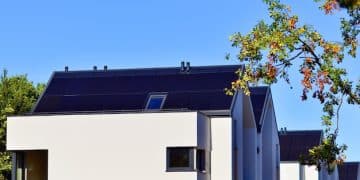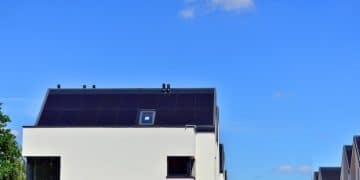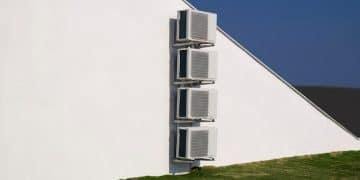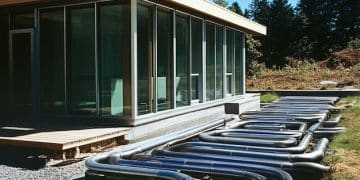Energy-Efficient Roofs: Cool Roofs & Lower AC Bills
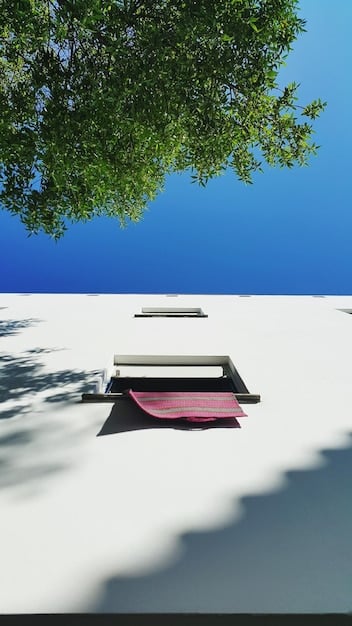
Energy-efficient roofs, particularly those using cool roof technology, are designed to reflect more sunlight and absorb less heat than standard roofs, significantly reducing your air conditioning bills and enhancing overall energy efficiency.
Are you looking for ways to reduce your energy consumption and lower your air conditioning bills? Energy-efficient roofs, particularly those incorporating cool roof technology, can be a game-changer for homeowners and businesses alike, providing not only cost savings but also environmental benefits.
Understanding Energy-Efficient Roofs
Energy-efficient roofs are designed to minimize heat absorption and maximize heat reflection, keeping buildings cooler and reducing the need for air conditioning. This section dives into what makes a roof energy-efficient and the benefits it offers.
What Makes a Roof Energy-Efficient?
An energy-efficient roof uses materials and designs that reflect sunlight and emit thermal radiation. This prevents the roof from overheating and transferring heat into the building.
Benefits of Energy-Efficient Roofs
Beyond lower energy bills, energy-efficient roofs offer a range of benefits that extend to both your wallet and the environment.
- Reduce AC bills: By keeping your home cooler, you’ll use your air conditioner less.
- Increase comfort: A cooler roof translates to a more comfortable indoor environment.
- Extend roof lifespan: Reduced thermal stress can prolong the life of roofing materials.
- Environmental benefits: Lower energy consumption reduces greenhouse gas emissions.
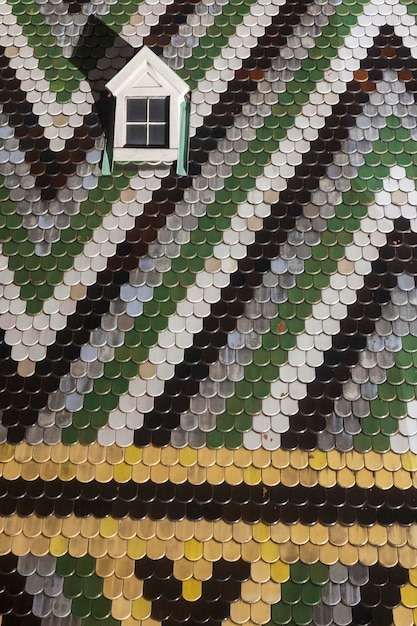
In conclusion, energy-efficient roofs are a smart investment for anyone looking to save money, improve comfort, and reduce their environmental footprint.
Exploring Cool Roof Technology
Cool roof technology is a subset of energy-efficient roofing that focuses specifically on highly reflective and emissive materials. This section explores the intricacies of cool roofs and how they work.
How Cool Roofs Work
Cool roofs work by reflecting a significant portion of incoming sunlight and emitting absorbed heat quickly. This reduces the roof’s surface temperature and the amount of heat transferred into the building.
Types of Cool Roof Materials
There are several types of materials used in cool roof construction, each with its own advantages and applications.
- Reflective coatings: These are applied to existing roofs to enhance reflectivity.
- Cool roof shingles: Specially designed shingles with high reflectivity.
- Tile roofs: Certain types of tiles are naturally reflective.
- Green roofs: Planted roofs that provide insulation and cooling.
Cool roof technology can significantly improve a building’s energy efficiency, reduce urban heat island effects, and contribute to a more sustainable environment.
Choosing the Right Energy-Efficient Roofing Material
Selecting the right roofing material is crucial for achieving the desired energy efficiency and cost savings. This section guides you through the factors to consider when making your choice.
Factors to Consider
Several factors influence the suitability of a roofing material for your specific needs.
- Climate: Different climates require different roofing solutions.
- Budget: Roofing materials vary widely in price.
- Aesthetic preferences: Choose a material that complements your home’s style.
- Roof slope: Some materials are better suited for steep or low-sloped roofs.
Comparing Roofing Materials
Let’s compare some popular energy-efficient roofing materials:
Metal Roofs: Highly reflective and durable, but can be expensive.
Asphalt Shingles: Energy-efficient options are available at a lower cost.
Tile Roofs: Naturally reflective and long-lasting, but heavy.

Ultimately, the best roofing material depends on your individual circumstances and priorities.
Installation and Maintenance of Energy-Efficient Roofs
Proper installation and regular maintenance are essential to ensure that your energy-efficient roof performs optimally and lasts for many years. This section outlines the best practices for both.
Professional Installation
Hiring a qualified roofing contractor is crucial for a successful installation. A professional will ensure that the roofing materials are installed correctly and that any necessary flashing and sealing are properly done.
Maintenance Tips
Regular maintenance can extend the lifespan of your roof and maintain its energy efficiency.
Annual Inspections: Check for any signs of damage or wear.
Clean Debris: Remove leaves, branches, and other debris that can trap moisture and promote mold growth.
Repair Damages Promptly: Address any leaks or damaged shingles right away.
By following these guidelines, you can ensure that your energy-efficient roof continues to provide cost savings and environmental benefits for years to come.
Cost and Return on Investment
While energy-efficient roofs may have a higher initial cost, the long-term savings and benefits can make them a worthwhile investment. This section examines the costs involved and the potential return on investment.
Initial Costs
The initial cost of an energy-efficient roof can vary depending on the type of material, the size of your roof, and the complexity of the installation. Generally, expect to pay more upfront compared to traditional roofing materials.
Long-Term Savings
The primary benefit of an energy-efficient roof is reduced energy consumption. Over time, these savings can offset the initial cost and provide a significant return on investment.
Government Incentives and Rebates
Many local, state, and federal governments offer incentives and rebates for installing energy-efficient roofing. Be sure to research available programs in your area to further reduce your costs.
Investing in an energy-efficient roof is a decision that pays off in the long run, both financially and environmentally.
The Future of Energy-Efficient Roofing
The field of energy-efficient roofing is constantly evolving, with new materials and technologies emerging regularly. This section explores some of the latest trends and future innovations in the industry.
Emerging Technologies
Researchers are continually developing new and improved roofing materials that offer even greater energy efficiency and durability. Some promising technologies include:
- Advanced reflective coatings: Coatings with higher solar reflectance and thermal emittance.
- Smart roofs: Roofs that can adjust their reflectivity based on weather conditions.
- Integrated solar roofing: Roofs that combine solar panels with roofing materials.
Sustainability Trends
As sustainability becomes increasingly important, the demand for eco-friendly roofing options is growing. Green roofs, made with sustainable materials, are gaining popularity as people strive to create more environmentally friendly buildings.
The future of energy-efficient roofing is bright, with ongoing innovations promising even greater energy savings and environmental benefits.
| Key Point | Brief Description |
|---|---|
| 💡 Reduced AC Bills | Cool roofs reflect sunlight and emit heat, lowering the need for air conditioning. |
| 🌱 Environmental Impact | Lower energy consumption reduces greenhouse gas emissions, benefiting the environment. |
| 💰 Potential Savings | Government incentives and long-term energy savings can offset initial installation costs. |
| 🏠 Increased Comfort | Cool roofs help maintain a more consistent and comfortable indoor temperature. |
Frequently Asked Questions
▼
A cool roof is designed to reflect more sunlight and absorb less heat than a standard roof, keeping buildings cooler and reducing energy consumption.
▼
Savings vary depending on climate, building characteristics, and roofing material, but homeowners can typically save 10-30% on cooling costs.
▼
Yes, many local, state, and federal governments offer incentives for installing energy-efficient roofing. Check your local energy provider’s website for details.
▼
Metal roofs, cool roof shingles, tile roofs, and green roofs are all effective options for reducing heat absorption and improving energy efficiency.
▼
The lifespan of an energy-efficient roof depends on the material and installation quality, but most can last 20-50 years with proper maintenance.
Conclusion
Investing in energy-efficient roofs with cool roof technology is a smart move for homeowners and businesses seeking to lower their AC bills, reduce their environmental impact, and enhance overall comfort. By choosing the right materials, ensuring proper installation, and taking advantage of available incentives, you can enjoy significant long-term savings and a more sustainable future.
